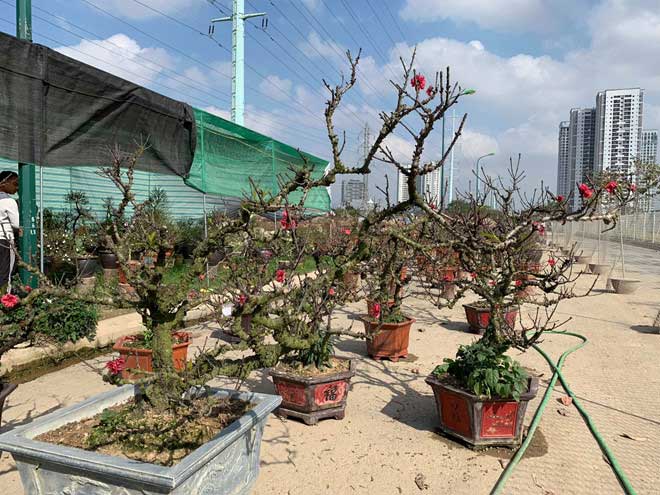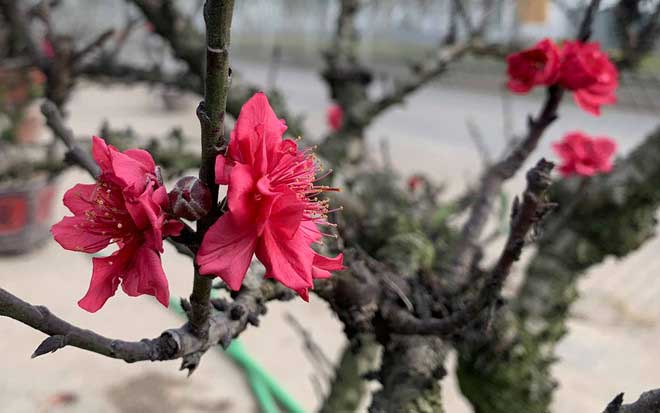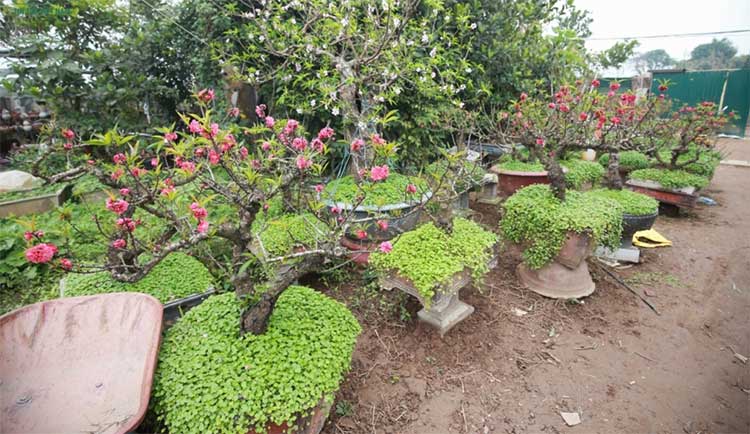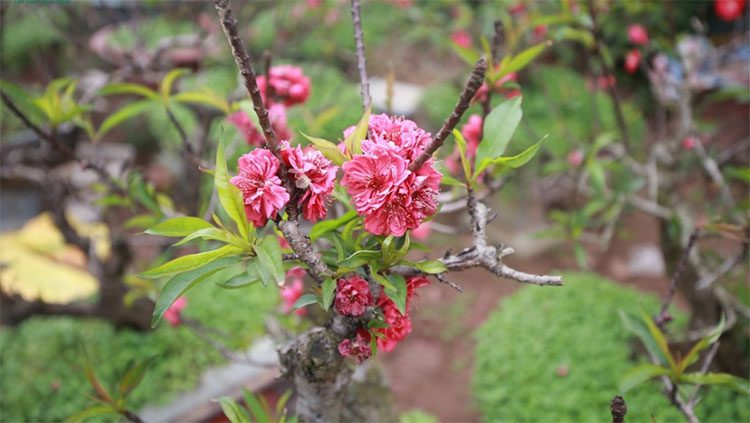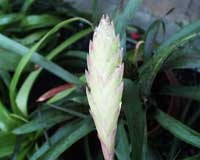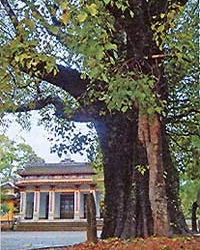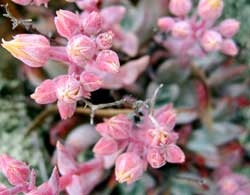The Thất Thốn peach is a rare and ancient ornamental peach tree known for its vigorous growth. The tree has a low stature with large, elongated leaves of a deep green color. Its trunk and branches are gnarled and knotted, giving it a unique, aged appearance.
With the Lunar New Year approaching, families are busy acquiring ornamental flowers to decorate their homes. Naturally, the peach blossom, a quintessential flower for Tet, cannot be overlooked.
It would be a significant oversight not to mention the Thất Thốn peach – also known as the royal peach – a tree that was traditionally admired only by the wealthy and royal classes in ancient times.
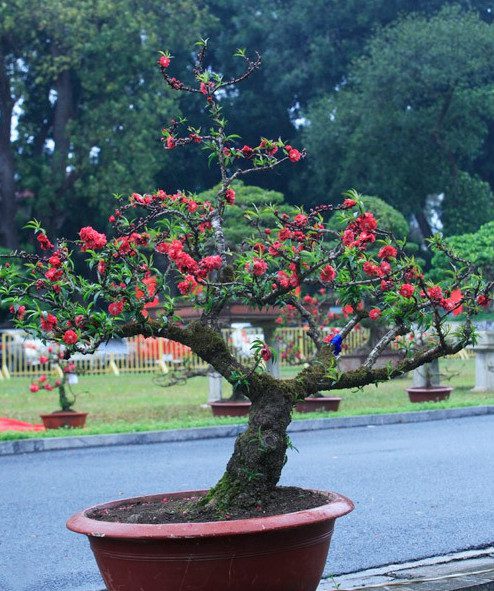
An ancient Thất Thốn peach tree priced at 160 million VND, featuring a stunningly straight trunk with a slightly swollen base.
The Thất Thốn peach has gained significant popularity as many are curious about this royal flower, not to mention its rather “staggering” price. A mini Thất Thốn peach tree in Hanoi, measuring 30 to 40cm, can cost around 2,000,000 to 2,500,000 VND per pot, while larger and more beautiful trees can fetch prices in the tens or even hundreds of millions of VND.
What makes this type of peach special is that it blooms at the base, on the branches, and on the trunk, with large, blood-red flowers featuring thick, beautiful petals. The vivid red of the peach blossoms, combined with the bright yellow stamens, can illuminate an entire space and evoke the warmth of spring. Interestingly, the more flowers that bloom, the quicker the branches fade, while trees with fewer blossoms tend to last longer.
Peach enthusiasts often share the saying “counting flowers counts as money” to describe the high cost of Thất Thốn. It’s rumored that in years when peach yields are low, each blossom can be valued at 10 million VND.
What is Thất Thốn Peach?
According to peach growers, Thất Thốn peach is an ancient, rare, and very expensive type of peach.
Although the origin and name of Thất Thốn peach date back a long time, its precise explanation remains a mystery.

Thất Thốn peach is an ancient, rare, and very expensive type of peach.
Some people explain the name Thất Thốn in three ways:
- The first is that every Thất Thốn peach tree produces branches every 7 “thốn” (each thốn is approximately the length of a finger joint), with each branch typically bearing 7 flowers, symbolizing the number seven.
- The second meaning is that the leaves of the Thất Thốn peach are about 7 thốn long, which is 3 to 4 times longer than those of common peaches.
- The third meaning is that it takes 7 years for the Thất Thốn peach to produce double-layered flowers with 7 petals each.
At night, the flowers emit a faint fragrance that is not found in regular peach varieties.
Distinct from other peach varieties, the color of Thất Thốn flowers is also notably vibrant.
The blossoms are rich in color, not too dark, with large buds that bloom into big flowers, and the double petals exude vitality. The leaves and shoots are thick, dark green, and extend uniformly around the branches.
On each thốn of the tree, several dozen flowers can bloom simultaneously. Believe it or not, some double-layered peach flowers can have between 30 to 50 petals each.
When the flowers fade, they do not drop their petals like other peach varieties; instead, they remain intact on the flower stalk.
Interestingly, the flowers grow in “clusters” of a few blooms, but if one flower blossoms before the others, it can overshadow the others, preventing them from blooming beautifully together.

Flowers grow in “clusters” of a few.
The Thất Thốn peach is small, reaching only about 1 meter in height, with a gnarled, rough trunk that appears like old firewood in winter. If the bark is peeled away, it reveals a dark purple color rather than the typical wood color of other peach varieties.
There are trees without leaves, buds, or flowers, with blackened buds, yet hidden deep within those “wooden branches” are the dormant peach buds waiting to sprout.
What’s particularly special is that Thất Thốn peach flowers can also bloom at the base and along the trunk. Some trees have flowers growing close to the ground, while others may hold buds for several years before blooming.
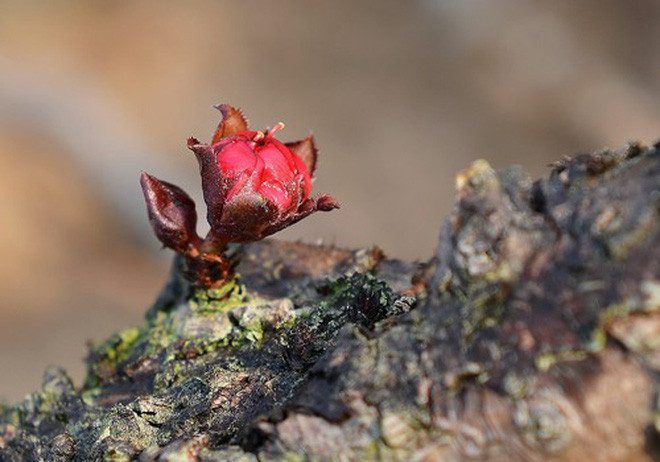
Flowers bloom from the base and trunk – a unique feature of Thất Thốn peach.
A particularly “unpleasant” aspect of the Thất Thốn peach is that it never blooms in time for the Tet holiday.
Instead, the Thất Thốn peach usually blooms around the 15th day of the first lunar month to welcome the “month of festivities.”
As a result, gardeners often have to employ various methods to force the Thất Thốn peach to bloom on time for Tet, such as using heating in greenhouses… However, this can be quite challenging.
Unlike other peach varieties, it may take approximately 10 to 12 years of careful cultivation to grow a mature Thất Thốn peach tree suitable for harvesting.
Perhaps it is the whimsical, proud, delicate, and “exotic” nature of the Thất Thốn peach that has earned it the name “royal peach,” reserved for the appreciation of the wealthy and royalty of ancient times.
Where is Thất Thốn Peach Grown?
Nhật Tân, Hanoi
The name Thất Thốn peach may sound unfamiliar to some residents of Hanoi, yet this flower is revered among enthusiasts as the most regal of peach varieties. In the past, almost every household in Nhật Tân had Thất Thốn peach trees. These trees typically bloom after the 15th day of the first lunar month and are considered a unique flower for festivals.
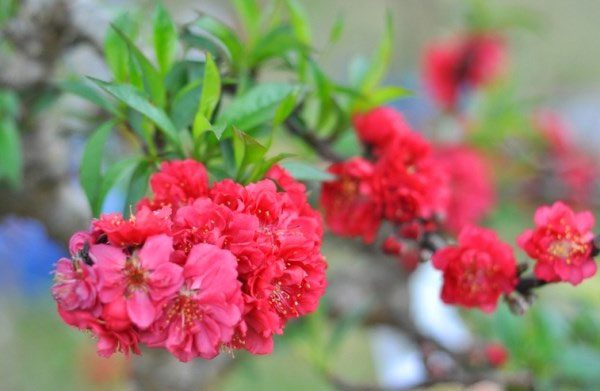
Thất Thốn red from roots to buds, sharp and strong like a sword.
No one is quite sure how this flower came to be in Nhật Tân or when it first appeared. Many people love this flower so much that they have given it various names, such as worship peach, fortune peach, and royal peach… The peach blossom is unique in that it can bloom and bear fruit even when cut from its branch. The more barren the soil, the more beautiful the flowers become. Thất Thốn has an even stronger vitality, capable of thriving in pots, while regular peach trees typically only last about three years. The Thất Thốn tree has a short stature, a gnarled, swollen trunk, large, elongated dark green leaves, and if the bark is peeled off, it reveals a purple color rather than the typical wood color of other peach trees.
This gnarled and mossy peach variety has an unusual charm; each thốn of the branch, equivalent to the length of a finger joint, can produce up to seven blooms, hence the name Thất Thốn. Thất Thốn boasts a vibrant red color from the roots to the buds, sharp and sturdy like a sword. The flowers are incredibly vivid, resembling velvet roses, and can bloom from the base. Some enthusiasts have reported counting up to three weeks of blooming, showcasing a beauty unmatched by any other peach variety.
Thất Thốn Peach in Đà Lạt
The Đà Lạt Thất Thốn peach is an ornamental tree characterized by its low stature, natural beauty, abundant blooms, fruit-bearing capability, longevity, and its scientific name, Prunus Persica, belonging to the Rosaceae family.
The Đà Lạt Thất Thốn was first cultivated by a gardener in Đà Thiện Commune (Đà Lạt) – Mr. Vũ Hữu Sửu, back in 1968. Later, another gardener from Hà Đông Commune (Đà Lạt) – Mr. Ngô Nhật Tiên, introduced the tree into pots to enhance its artistic growth. Today, Đà Lạt Thất Thốn can be found in most gardens of artisans in Đà Lạt.
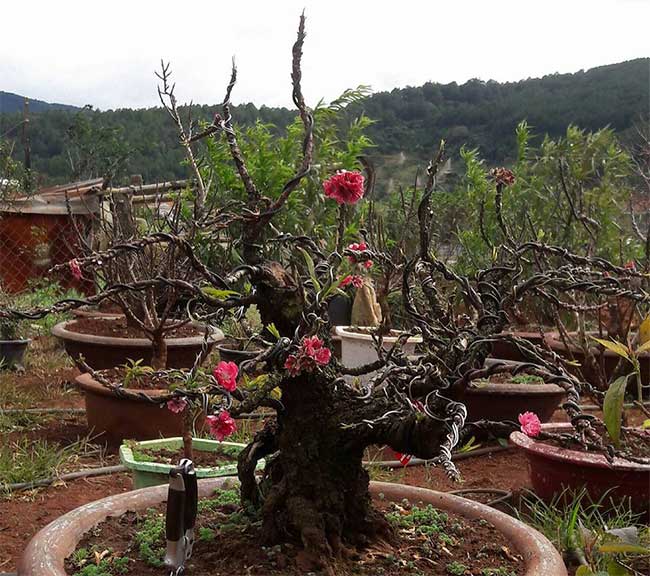
Đà Lạt Thất Thốn can be propagated by grafting, cutting, and seed sowing.
The Đà Lạt Thất Thốn is a highly valued artistic plant in bonsai, with some specimens priced in the tens of millions of VND. Besides characteristics similar to regular peaches, such as simple leaves, lanceolate shape, alternate arrangement, serrated edges; the gray bark of old stems; round fruit with a pointed end; oval seeds with one pointed end and bumpy surface, it also has the following additional features:
- 1. The canopy is often very dense due to overlapping leaves, and the leaves of the Dalat peach (Prunus persica var. dulcis ‘Thất Thốn’) are larger and longer than those of the common peach; measuring 10-20 cm in length and 1.5-2 cm in width. The young leaves of the Dalat peach are green, while the young leaves of the Hanoi peach have a dark reddish-green tint. The Hanoi peach has shorter and smaller leaves compared to the Dalat variety.
- 2. At the nodes, the distance between the leaves of the Dalat peach is very short, with 5-7 leaves per centimeter under normal light conditions. This is the reason for the slow growth in height of the tree, as the branches and trunk of the peach only grow about 3-5 cm each year.
- 3. The branches and trunk of the Thất Thốn peach are generally hard and brittle, making them difficult to bend, especially once they have matured.
- 4. The trunk has many scar scales. The bark of the mature tree is usually gray, while the trunk of the Hanoi peach is dark brown.
- 5. The flowers of the Dalat Thất Thốn peach are pale pink, with five petals, a single pistil, about 25 stamens, and pollen sacs. The Hanoi peach has smaller, double flowers that are dark red and typically blooms en masse around the Tet holiday. While the Dalat peach also flowers at this time, its blooming period is longer and more sporadic.
- 6. The fruit of the Dalat Thất Thốn peach is large, averaging 4-6 cm in diameter, with a yellow color and dark pink blush. The seeds are smaller than those of the common peach, and the fruit has a thin skin with few hairs. The Dalat peach is very productive, and its flowers are self-pollinating, requiring no cross-pollination with other peach varieties.
- 7. The lifespan of the Dalat Thất Thốn peach is relatively short because it is a specific variety from Dalat, where the winter temperatures do not last as long as in Hanoi.
- 8. The tree has ornamental value twice: once during Tet when it blooms, and again around the fourth lunar month when its fruit ripens and weighs down the branches.
- 9. The lifespan of the Thất Thốn peach has not been precisely determined, but growers note that trees at 20 years of age still produce many flowers and fruits. Specifically, trees in Da Thien, planted since 1968, are still thriving today.
The Dalat Thất Thốn peach can be propagated through grafting, layering, and seed sowing; however, trees grown from seeds are considered more valuable due to their ease of care and longer lifespan.
The soil and nutritional requirements for the Thất Thốn peach are similar to those of the common peach, except that when grown in pots, the peach must be exposed to light for about 10 hours a day, including 6 hours of direct sunlight. When placing the tree on a patio, it is advisable to position it close to a south-facing wall to maximize light exposure, particularly from reflections off the wall. This way, the Thất Thốn peach can develop well, and the fruit will ripen to a dark red color.
Beautiful Shapes of the Thất Thốn Peach
The Thất Thốn peach generally has a naturally beautiful shape that does not require styling. However, growers often follow these trends:
- Mushroom shape: This shape is commonly favored by artisans in Hanoi when planting the Hanoi Thất Thốn peach (according to Hanoi Electronic Newspaper – The Fragile Fate of Thất Thốn Peach).
- Bonsai style shaping: Some bonsai artists often prune and shape the tree into traditional forms (according to luaviet.com.au/Essence of Vietnam).
- Natural horizontal growth shape: This form involves pinching the tips to encourage branches to grow away from the main trunk, allowing the tree to absorb more light, produce more fruit, and ripen evenly and sweetly.
Peach enthusiasts must enjoy the entire tree in a pot rather than just branches.
Beautiful Photos of the Thất Thốn Peach

